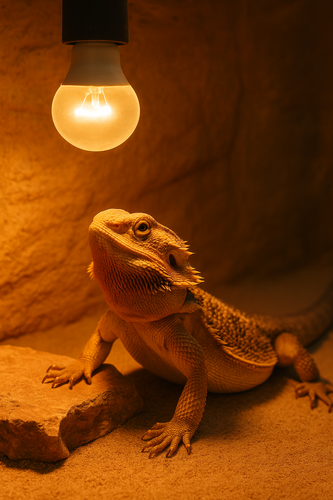Have you got the correct lighting for your pet reptile?
28th Aug 2025
Checking Your Reptile’s Lighting After Brumation
As reptiles wake from brumation and return to their normal activity levels, it’s not just food and hydration that matter — proper lighting is critical for their health. Reptiles rely on UVB and UVA lighting to regulate behaviour, metabolism, and skeletal health. After months of reduced activity during brumation, this is the perfect time to check that your lighting setup is still working effectively.
Why Lighting Matters
-
UVB light enables reptiles to produce vitamin D3, which is essential for calcium absorption and strong bones. Without it, reptiles can suffer from metabolic bone disease.
-
UVA light influences natural behaviours such as basking, feeding, and breeding.
Even if a bulb still appears to be working, its UVB output diminishes over time. This means your reptile may not be getting the level of radiation they need, even under a glowing lamp.
Step 1: Check the Bulb’s Age
Most UVB bulbs are only effective for 3–6 months, depending on the brand and type. Mark the installation date on the bulb or enclosure when you first set it up. If your bulb is nearing or past its recommended lifespan, replace it before your reptile misses out on crucial UV exposure.
Step 2: Use a UVB Sensor
A reliable way to test your lighting is with a UVB sensor or UVB meter. This tool measures the actual UVB output at the basking site and helps you know if your bulb is still providing the right intensity.
-
Place the sensor at your reptile’s basking spot.
-
Compare the reading against the recommended levels for your species.
-
If the output is too low, it’s time to replace the bulb.
By using a sensor, you remove the guesswork and ensure your reptile is getting the light they need to stay healthy.
Step 3: Check Positioning and Distance
Ensure your bulb is positioned correctly:
-
The basking spot should be within the manufacturer’s recommended distance for UV exposure.
-
Barriers like glass or plastic block UVB, so lights must shine directly into the enclosure.
-
Angle fixtures to create a UV gradient, allowing your reptile to self-regulate their exposure.
Step 4: Combine with Heat and Photoperiod
Reptiles need both heat and UVB for proper digestion and activity. After brumation, re-establish the correct basking temperatures and day-night cycle. Most reptiles thrive on 10–14 hours of light per day, depending on the season and species.
Supporting Products from BioSupplies
At BioSupplie, we stock a range of lighting solutions to keep your reptiles thriving:
-
UVB and UVA bulbs – essential for skeletal growth and natural behaviour.
-
Timers and controllers – to maintain consistent day-night cycles.
-
Feeding supplements – like calcium powders and insect purees, to support nutrition alongside correct lighting.
Final Thoughts
Lighting is just as important as food and hydration when your reptile wakes from brumation. By checking the age of your bulbs, testing with a UVB sensor, and ensuring proper placement, you’ll give your reptile the best chance at a strong, healthy season ahead.
Explore our range of reptile lighting and accessories to keep your pets glowing with good health.

